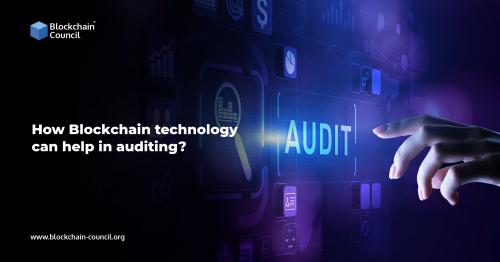How Blockchain technology can help in auditing?

Despite its youth, blockchain technology has immense promise. Using the technical platform, organisations may design processes that are easier to audit and hence more accurate and transparent for auditors to review. Transparency to third parties in real time may be possible with blockchain technology, which might remove the need for confirmations and reconciliations in the future.
Blockchain education is on the rise with more and more people enrolling in blockchain course.
Read More- how to become a blockchain engineer
Blockchain-based auditing approach
Existence, rights, and responsibilities:
Digital asset accounts (also known as wallets) can only be identified by their unique combination of random numbers and letters. It's possible for individuals and businesses alike to utilise blockchain technology to "own their own bank" and retain full control of their cash. It's now more difficult to verify the possession of digital assets, such as proving the ownership of one wallet over another.
Completeness:
On a Blockchain platform, the issue of completeness is not so much whether there are "hidden" digital assets, but rather whether managed wallets are being illegally omitted from the books and records of the Blockchain platform. The client's wallet listing should generally match the amount on the financial statements. Any discrepancy in the total number of wallets listed or recorded in the books and records suggests that customers are not reporting or registering all of their wallets correctly.
Accuracy:
When it comes to storing and retrieving information, a blockchain is more accurate than a regular database. As long as the auditor can trust the data, they may be able to reduce the risk of erroneous information concerning digital assets. However, information that is not related to digital assets or entered into the blockchain by an outside source does not have the same level of credibility. Erroneous data might be recorded as a result of human mistake.
Cutoff:
One of the most significant aspects of blockchain is the time stamping of every transaction and data input. Real-time transactions may be verified using the blockchain to provide proof of the proper cutoff point. Accordingly, the auditor is responsible for determining the proper cutoff point, and this obligation cannot be abolished by utilising a blockchain since the recording of transactions or events at a specific moment in time may not necessarily represent acceptable accounting treatment. Paying a service provider bill that should be deducted over time or transferring the ownership of merchandise that is in transit are instances of this.
Wrapping up
Blockchain technology, at its foundation, is a new, encrypted digital accounting method. Because of the increased openness that blockchain provides, we must rethink how we do audits. Both parties to a transaction may use the same blockchain platform to record all of the necessary documentation (authorizations, journal entries, etc.), as well as execute the value transfer. Due to the real-time nature of a blockchain, the need for confirmations or reconciliations might be eliminated if all parties used the same blockchain. Continuous real-time monitoring takes the audit from a retroactive or forensic point in time approach. When a transaction is completed, the foundations of audit and internal control are firmly established.
Blockchain experts are in high demand right now. Get started by signing up for a blockchain course.
Post Your Ad Here
Comments